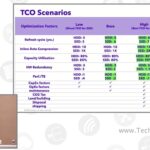|
|

Manzur Rahman presented for Solidigm at AIDIFD1 |
This video is part of the appearance, “Solidigm Presents at AI Data Infrastructure Field Day 1“. It was recorded as part of AI Data Infrastructure Field Day 1 at 10:30-12:30 on October 3, 2024.
Watch on YouTube
Watch on Vimeo
Manzur Rahman from Solidigm presented an in-depth analysis of Total Cost of Ownership (TCO) for data centers, emphasizing its growing importance in the AI era. TCO encompasses acquisition, operation, and maintenance costs, and is crucial for evaluating cost-effective, high-performance hardware like GPUs, storage, and AI chips. Rahman highlighted the need for energy-efficient solutions and the importance of right-sizing storage to avoid over or under-provisioning. He explained that TCO includes both direct costs (materials, labor, energy) and indirect costs (overheads, cooling, carbon tax), and uses a normalization method to provide a comprehensive cost per terabyte effective per month per rack.
Rahman detailed Solidigm’s TCO model, which incorporates dynamic variables such as hardware configuration, drive replacement cycles, and workload mixes. The model also factors in the time value of money, maintenance, disposal costs, and greenhouse gas taxes. By comparing HDD and SSD racks under various scenarios, Solidigm found that SSDs can offer significant TCO benefits, especially when variables like replacement cycles, capacity utilization, and data compression are optimized. For instance, extending the SSD replacement cycle from five to seven years can improve TCO by 22%, and increasing capacity utilization can lead to a 67% improvement.
The presentation concluded with a sensitivity analysis showing that high-density QLC SSDs can significantly reduce TCO compared to HDDs. Even with higher upfront costs, the overall TCO is lower due to better performance, longer replacement cycles, and higher capacity utilization. Rahman projected that high-density QLC SSDs will continue to offer TCO improvements in the coming years, making them a promising solution for data centers, particularly in AI environments. The analysis demonstrated that while CAPEX for SSDs is higher, the overall cost per terabyte effective is lower, making SSDs a cost-effective choice for future data center deployments.
Personnel: Manzur Rahman








